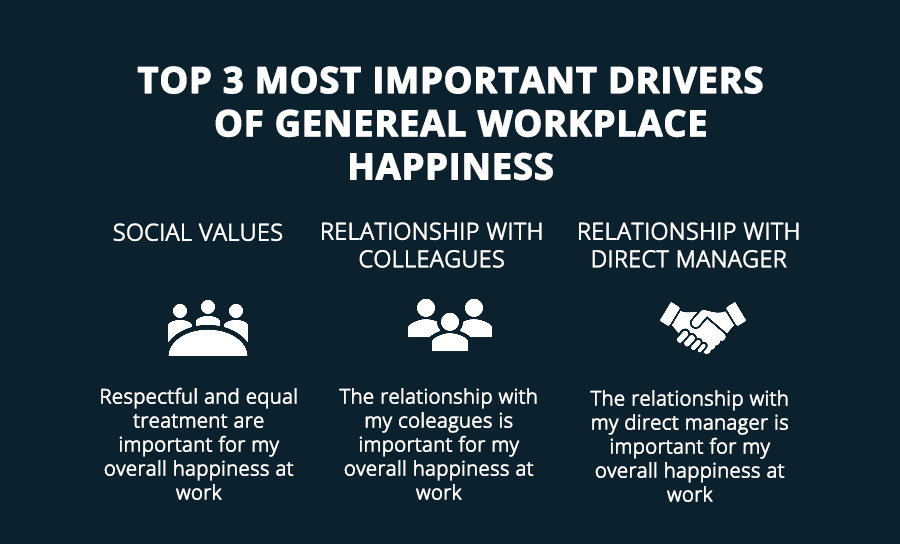An end to the Fluffiness in Employee Happiness

By Selma Fehrmann | 27/09/2018
Academic research proves that happiness at work is measurable, with mood as a key indicator.
Happiness at work has become a booming topic over the last years. Many organisations are now trying to implement strategies to improve the happiness of their employees. One of the main reasons is that having happy employees positively impacts collective productivity, innovation, and revenue. In addition it reduces stress, sickness leave, burn-outs and employee turnover. Another reason is that, in today’s business world, employers need to operate in close collaboration with their employees and know what their needs are in order to retain their talents and engagement in the organization.
Academic research on drivers of employee happiness
Because workplace happiness is such an up-and-coming topic, new research insights are being produced regularly. In collaboration with the University of Utrecht, we carried out academic research on drivers of a happy workplace in the last months. Specifically, we investigated how to best capture or measure employee happiness at work. Through literature research as well as extensive field studies in which respondents from more than 150 organizations participated, we found several key aspects that are important for accurate measurement and attainment of happiness. Also, we took the time to scientifically validate our own 2DAYSMOOD analysis tool and make sure it is up to the latest standards!
Measuring happiness at work is possible
The most important finding from our research is that there is no single measurement that can capture happiness at work accurately. What you need is a combination of four measurements including: job satisfaction levels, engagement, organizational commitment as well as emotions and affect.
- Job satisfaction is the emotional state resulting from one’s job or aspects of the job, such as growth opportunities, the level of autonomy and mastery, salary & benefits and appreciation.
- Engagement is the extent to which an employee devotes cognitive (head), emotional (heart) and physical (body) attention to their profession. Job satisfaction and engagement are typically measured in traditional yearly engagement surveys.
- Organizational commitment is the extent to which an employee personally identifies with the organization they work for. A typical measurement for organizational commitment is the employee Net Promotor Score (eNPS) that measures employee loyalty based on the presence of three different groups of employees, namely: detractors, passives and promotors.
- Emotions and Affect indicate the general attitude or mood at work. Knowing how employees feel at work and why seems to be an important aspect of obtaining insight in overall happiness at work.
Continuous vs. Yearly measurements
Another important feature of accurately measuring happiness at work is through repeated measurements. If you really want to know how your employees are doing, a bi-yearly survey is not going to cut it. Make sure to ask your employees how they are feeling every week or even twice per week! This gives you the opportunity to see immediate effects of changes and initiatives in the organization. Besides, adding up these measurements over a longer period of time enables you to see trends and gives you a good impression of how your organization is progressing!
Moods at work are universal
We set out a survey to measure whether moods experienced by employees at work can be generalized across cultures. And the answer is yes! We asked respondents from several nationalities and organizations across different countries to rate their 8 most frequent experienced emotions or feelings at work. We found significant overlap between the reported moods and can conclude that emotions felt at work are very universal. Do you want to know what the single most reported feeling was? It may not be surprising to you that most respondents answered that they are often tired. Luckily, people were also very often cheerful, enthusiastic and relaxed! We also found that the most accurate way to measure employee emotions or affect is not through a verbal measure, but through a faces scale. People can judge and express their feelings better when they are able to relate to emojis with clear facial expressions.
Happiness at work is mostly influenced by people
Knowing what measurements give a representative picture of happiness at work, we were also interested in what key drivers in organizations have the highest impact on positive business outcomes (KPIs). We found that across cultures, the most important drivers of overall happiness at work are strongly people and socially related, namely: social values, relationship with colleagues as well as relationship with direct managers.
A continuous, holistic approach is most effective
Organizations that want to start implementing strategies to improve the happiness and wellbeing of their employees or are already doing so, will need to have insight in overall happiness. The specifically combined measurement variables work best, to be able to see the effects on organizational KPIs. Moreover, a continuous measuring approach is most effective, since it enables organizations to be more agile and get insight in the immediate impact of their actions or certain events. Frequent measurements and feedback are the first steps towards happy employees and a positive organizational culture. 2DAYSMOOD has implemented this knowledge in the Employee Happiness Model and a fun innovative analysis tool that measures engagement and happiness in just 15 seconds a week. An alternative for the yearly, often ineffective, employee satisfaction survey or even performance appraisals. In addition the organizational psychologists and HR experts in our team are dedicated to inspiring and advising CEOs, managers and employees. We motivate them to take action for a positive working climate.
Interested in measuring and improving employee happiness in your organisation or team? Or do you want to learn more about our variety of measurements and data analyses in our tool? Get in touch with us via [email protected] or get a free demo.
With thanks to:
Karien Timmerman – Research Intern, 2DAYSMOOD
Selma Fehrmann – Organizational Psychologist & Director EMEA, 2DAYSMOOD
View the infographic:
